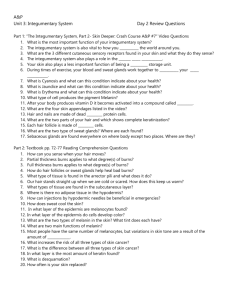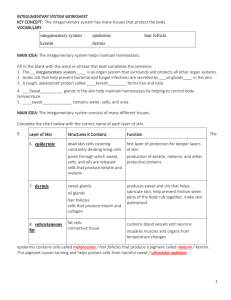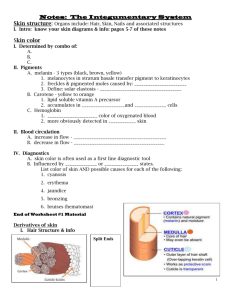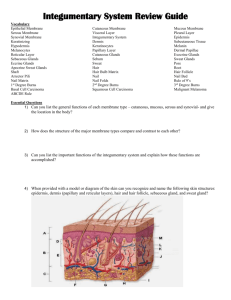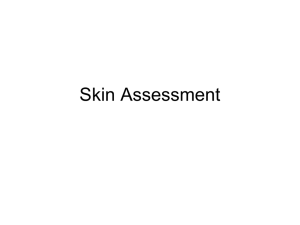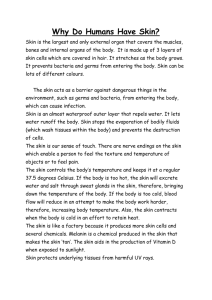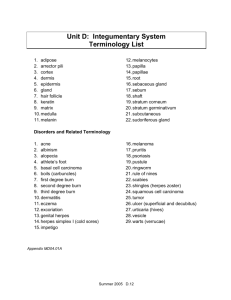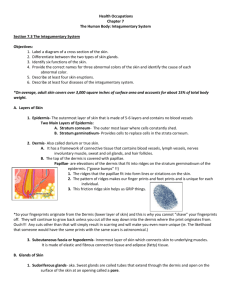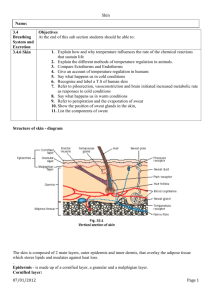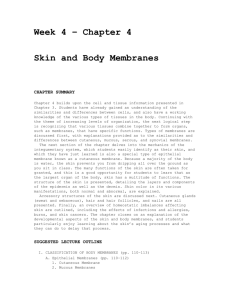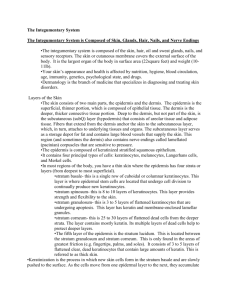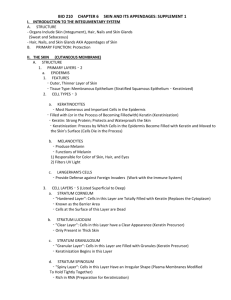Integumentary System Notes
advertisement
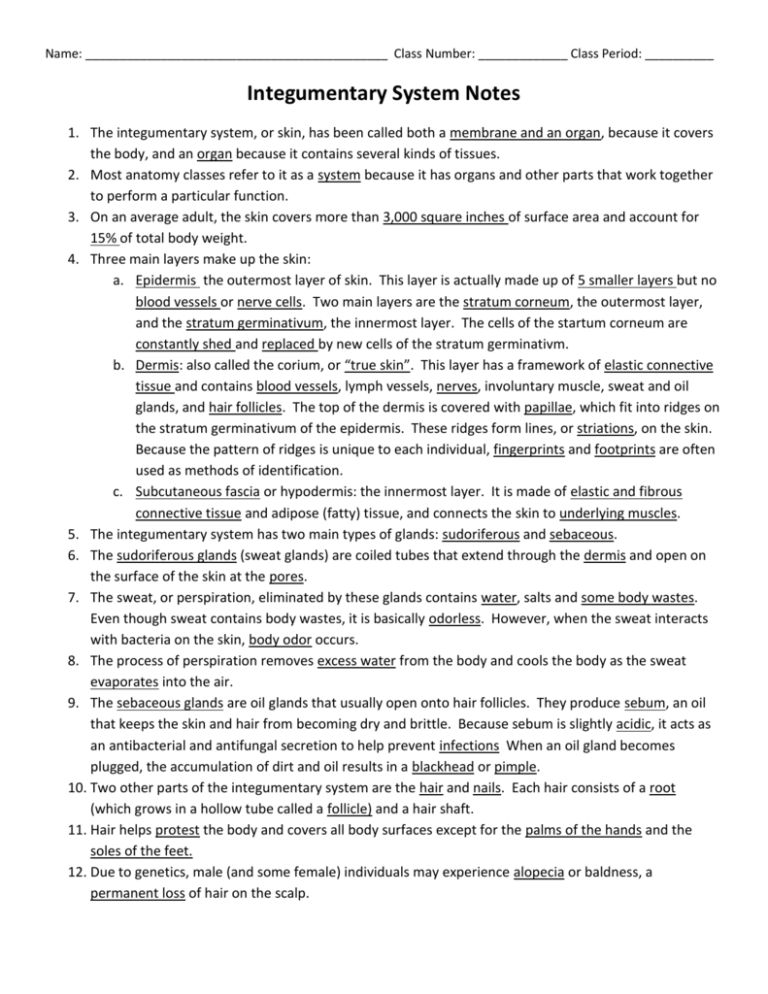
Name: ____________________________________________ Class Number: _____________ Class Period: __________ Integumentary System Notes 1. The integumentary system, or skin, has been called both a membrane and an organ, because it covers the body, and an organ because it contains several kinds of tissues. 2. Most anatomy classes refer to it as a system because it has organs and other parts that work together to perform a particular function. 3. On an average adult, the skin covers more than 3,000 square inches of surface area and account for 15% of total body weight. 4. Three main layers make up the skin: a. Epidermis the outermost layer of skin. This layer is actually made up of 5 smaller layers but no blood vessels or nerve cells. Two main layers are the stratum corneum, the outermost layer, and the stratum germinativum, the innermost layer. The cells of the startum corneum are constantly shed and replaced by new cells of the stratum germinativm. b. Dermis: also called the corium, or “true skin”. This layer has a framework of elastic connective tissue and contains blood vessels, lymph vessels, nerves, involuntary muscle, sweat and oil glands, and hair follicles. The top of the dermis is covered with papillae, which fit into ridges on the stratum germinativum of the epidermis. These ridges form lines, or striations, on the skin. Because the pattern of ridges is unique to each individual, fingerprints and footprints are often used as methods of identification. c. Subcutaneous fascia or hypodermis: the innermost layer. It is made of elastic and fibrous connective tissue and adipose (fatty) tissue, and connects the skin to underlying muscles. 5. The integumentary system has two main types of glands: sudoriferous and sebaceous. 6. The sudoriferous glands (sweat glands) are coiled tubes that extend through the dermis and open on the surface of the skin at the pores. 7. The sweat, or perspiration, eliminated by these glands contains water, salts and some body wastes. Even though sweat contains body wastes, it is basically odorless. However, when the sweat interacts with bacteria on the skin, body odor occurs. 8. The process of perspiration removes excess water from the body and cools the body as the sweat evaporates into the air. 9. The sebaceous glands are oil glands that usually open onto hair follicles. They produce sebum, an oil that keeps the skin and hair from becoming dry and brittle. Because sebum is slightly acidic, it acts as an antibacterial and antifungal secretion to help prevent infections When an oil gland becomes plugged, the accumulation of dirt and oil results in a blackhead or pimple. 10. Two other parts of the integumentary system are the hair and nails. Each hair consists of a root (which grows in a hollow tube called a follicle) and a hair shaft. 11. Hair helps protest the body and covers all body surfaces except for the palms of the hands and the soles of the feet. 12. Due to genetics, male (and some female) individuals may experience alopecia or baldness, a permanent loss of hair on the scalp. Name: ____________________________________________ Class Number: _____________ Class Period: __________ 13. Nails protect the fingers and toes from injury. They are made of dead keratinized epidermal epithelial cells packed closely together to form a thick, dense surface. They are formed in the nail bed. If lost, nails will regrow if the nail bed is not damaged. Functions – list and describe the 7 functions of the integumentary system. Be sure to include important vocabulary. The integumentary system performs the following important functions: 1. Protection: It serves as a barrier to the sun’s ultraviolet rays and the invasion of pathogens, or germs. It also holds moisture in and prevents deeper tissues from drying out. 2. Sensory perception: The nerves in the skin help the body respond to pain, pressure, temperature (heat and cold), and touch sensations. 3. Body temperature regulation: The blood vessels in the skin help the body retain or lose heat. When the blood vessels dilate (get larger), excess heat from the blood can escape through the skin. When the blood vessels constrict (get smaller), the heat is retained in the body. The sudoriferous glands also help cool the body through evaporation of perspiration. 4. Storage: The skin has tissues for temporary storage of fat, glucose (sugar), water, vitamins, and salts. Adipose (fatty) tissue in the subcutaneous fascia is a source of energy. 5. Absorption: Certain substances can be absorbed through the skin, such as medications for motion sickness or heart disease and nicotine patches to help stop smoking. The medications are placed on sticky patches and applied to the skin. This is called transdermal medication. 6. Excretion: The skin helps the body eliminate salt, a minute amount of waste, and excess water and heat through perspiration. 7. Production: The skin helps in the production of vitamin D by using ultraviolet rays from the sun to form an initial molecule of vitamin D that matures in the liver. Pigmentation 1. Basic skin color is inherited and is determined by pigments in the epidermis of the skin. 2. A brownish black pigment, melanin is produced in the epidermis by specialized cells called melanocytes. Even though everyone has the same number of melanocytes, genes present in each racial group determine the amount of melanin produced. 3. Melanin can lead to black, brown or yellow skin tint, depending on the amount of melanin present in the racial origin. Name: ____________________________________________ Class Number: _____________ Class Period: __________ 4. 5. 6. 7. Ultraviolet light activates the melanocytes to produce more melanin to protect and to tan the skin. Small concentrated areas of melanin pigment form freckles. Carotene, a yellowish red pigment, also helps determine skin color. A person with an absence of color pigments is an albino. An albino’s skin has a pinkish tint and the hair is pale yellow or white. The person’s eyes also lack pigment and are red and are very sensitive to the sun. 8. Abnormal colors of the skin can indicate disease. 9. Erythema is a reddish color of the skin that can be caused by either burns or a congestion of blood in the vessels. 10. Jaundice a yellow discoloration of the skin, can indicate bile in the blood as a result of liver or gallbladder disease. Jaundice also occurs in conjunction with certain diseases that involve the destruction of red blood cells. 11. Cyanosis is a bluish discoloration of the skin caused by insufficient oxygen. It can also be associated with heart, lung, and circulatory diseases or disorders. Chronic poisoning may cause a gray or brown skin discoloration. Skin Eruptions – Define the following skin eruptions that can also be associated with disease. 1. Macules: (macular rash) flat spots on the skin, such as freckles. 2. Papules: (papular rash) firm, raised areas such as pimples and the eruptions seen in some stages of chickenpox and syphilis. 3. Vesicles: blisters, or fluid-filled sacs such as those seen in chickenpox. 4. Pustules: pus-filled sacs such as those seen in acne, or pimples. 5. Crusts: areas of dried pus and blood, commonly called scabs. 6. Wheals: itchy, elevated areas with an irregular shape; hives and insect bites are examples. 7. Ulcer: a deep loss of skin surface that may extend into the dermis; may cause periodic bleeding and the formation of scars. 8. Cyst: a closed sac with a distinct membrane that develops abnormally in a body structure; usually filled with a semisolid material. Name: ____________________________________________ Class Number: _____________ Class Period: __________ Diseases and Abnormal Conditions – Pick 4 conditions from the book and describe them. 1. Name: Acne Vulgaris – an inflammation of the sebaceous glands. Cause is unknown, but it usually occurs in adolescence. Symptoms include papules, pustules, and blackheads. These occur when hair follicles become blocked with dirt, etc. Treatment methods include frequent, thorough skin washing. 2. Name: Athlete’s Foot – a contagious fungal infection that usually affects the feet. The skin itches, blisters, and cracks into open sores. Treatment involves topical and/or oral antifungal medications and keeping the area clean and dry. 3. Name: Skin Cancer – most common type of cancer. Three main types of skin cancer: a. Basal cell carcinoma: cancer of the basal cell in the epidermis of the skin. It grows slowly and does not usually spread. Lesions can be pink to yellow-white. They are usually smooth with a depressed center and an elevated, irregular-shaped border. b. Squamous cell carcinoma: affects the thin cells of the epithelium but can spread quickly to other areas of the body. The lesions start as small, firm, red, flat sores that later scale and crust. Sores that do not heal are frequently squamous cell carcinomas. c. Melanoma: develops in the melanocytes of the epidermis and is the most dangerous type of skin cancer. The lesions can be brown, black, pink, or multicolored. They are usually flat or slightly raised, asymmetric, and irregular or notched on the edges. 4. Name: Dermatitis – inflammation of the skin, can be caused by any substance that irritates the skin. It is frequently an allergic reaction. Symptoms include dry skin, erythema, itching, edema, macularpapular rashes, and scaling. 5. Name: Eczema – noncontagious, inflammatory dermatitis caused by an allergen or irritant. Symptoms include dryness, erythema, edema, itching, vesicles that crust or ooze, and scaling. 6. Name: Impetigo – highly contagious skin infection usually caused by strephococci or staphylococci organisms. Mainly affects infants and children. Symptoms include red lesions on the face, especially around the nose and mouth, or on other body surfaces. The lesions rupture and ooze forming a yellowish brown crust. Lesions should be washed with soap and water and kept dry. 7. Name: Psoriasis – chronic, noncontagious skin disease with periods of exacerbations and remissions. Symptoms include thick, red areas covered with white or silver scales. 8. Name: Ringworm – highly contagious fungal infection of the skin or scalp. The characteristic symptom is the formation of a flat or raised circular area with a healthy-looking inner area surrounded by an itchy, scaly, or crusty outer ring. Antifungal medications, both oral and topical, are used in treatment. Name: ____________________________________________ Class Number: _____________ Class Period: __________ 9. Name: Verrucae – warts caused by the human papilloma virus (HPV). Several different types depending on their location include genital, plantar, and palmar. A rough, hard, elevated, rounded surface forms on the skin. Some warts disappear spontaneously, but others must be removed.
